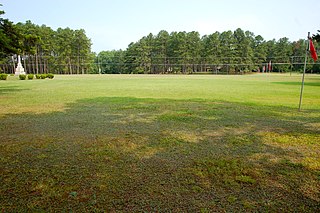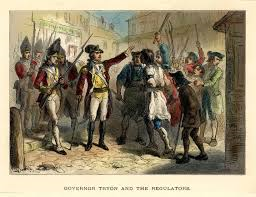
1771 (MDCCLXXI) was a common year starting on Tuesday of the Gregorian calendar and a common year starting on Saturday of the Julian calendar, the 1771st year of the Common Era (CE) and Anno Domini (AD) designations, the 771st year of the 2nd millennium, the 71st year of the 18th century, and the 2nd year of the 1770s decade. As of the start of 1771, the Gregorian calendar was 11 days ahead of the Julian calendar, which remained in localized use until 1923.

Orange County is a county located in the Piedmont region of the U.S. state of North Carolina. As of the 2020 census, the population was 148,696. Its county seat is Hillsborough.
Francis Nash was a brigadier general in the Continental Army during the American Revolutionary War. Prior to the war, he was a lawyer, public official, and politician in Hillsborough, North Carolina, and was heavily involved in opposing the Regulator movement, an uprising of settlers in the North Carolina piedmont between 1765 and 1771. Nash was also involved in North Carolina politics, representing Hillsborough on several occasions in the colonial North Carolina General Assembly.

Lieutenant-General William Tryon was a British Army officer and colonial administrator who served as governor of North Carolina from 1764 to 1771 and the governor of New York from 1771 to 1777. He also served during the Seven Years' War, the Regulator Movement, and the American War of Independence.
Tryon County is a former county which was located in the U.S. state of North Carolina. It was formed in 1768 from the part of Mecklenburg County west of the Catawba River, although the legislative act that created it did not become effective until April 10, 1769. Due to inaccurate and delayed surveying, Tryon County encompassed a large area of northwestern South Carolina. It was named for William Tryon, governor of the North Carolina Colony from 1765 to 1771.

Samuel Johnston was an American planter, lawyer, Grand Master of Freemasons, enslaver, and statesman from Chowan County, North Carolina. He represented North Carolina in both the Continental Congress and the United States Senate, and he was the sixth Governor of North Carolina.

Robert Howe was a Continental Army general from the Province of North Carolina during the American Revolutionary War. The descendant of a prominent family in North Carolina, Howe was one of five generals, and the only major general, in the Continental Army from that state. He also played a role in the colonial and state governments of North Carolina, serving in the legislative bodies of both.

Edmund Fanning was an American-born colonial administrator and military officer. Born in New York, he became a lawyer and politician in North Carolina in the 1760s. He first came to fame as the focus of hatred of the Regulators, and led anti-Regulator militia in the War of the Regulation. When the American Revolutionary War broke out, he was driven from his home in New York, and joined the British Army, recruiting other Loyalists. He served during campaigns in New England and the South. At the end of the war in 1783 he became a United Empire Loyalist, settling in Nova Scotia.
James Few was born in 1746 in Hartford. His parents were William Few, Sr., and Mary Wheeler. James migrated with his parents and siblings to Orange County, North Carolina circa 1758.

Alamance Battleground is a North Carolina State Historic Site commemorating the Battle of Alamance. The historic site is located south of Burlington, Alamance County, North Carolina in the United States.
James Moore was a Continental Army general during the American Revolutionary War. Moore was born into a prominent political family in the colonial Province of North Carolina, he was one of only five generals from North Carolina to serve in the Continental Army. He spent much of his childhood and youth on his family's estates in the lower Cape Fear River area, but soon became active in the colonial military structure in North Carolina.

General Hugh Waddell was an Irish-born American military officer in the Province of North Carolina prior to the American Revolutionary War. Waddell formed and led a provincial militia unit in Rowan County, North Carolina and the Ohio River Valley during the French and Indian War and the Anglo-Cherokee War, and supervised the construction of Fort Dobbs near the settlement of the Fourth Creek Congregation. His career was well-served by close connections to several provincial governors of North Carolina.

The Battle of Alamance, which took place on May 16, 1771, was the final battle of the Regulator Movement, a rebellion in colonial North Carolina over issues of taxation and local control. Named for nearby Great Alamance Creek, the battle took place in what was then Orange County and has since become Alamance County in the central Piedmont area, about 6 miles (9.7 km) south of present-day Burlington, North Carolina.
Thomas Eaton was a military officer in the North Carolina militia during the War of the Regulation in 1771 and American Revolutionary War from 1775 to 1784. He was a member of the North Carolina Provincial Congress and North Carolina House of Commons for several terms simultaneously with his military service. Eaton was a member of the North Carolina Council of State under Governor Richard Caswell. Eaton commanded soldiers in the battles of Brier Creek and Guilford Courthouse. At the time of the 1790 census, Eaton was one of the largest slaveholders in North Carolina.
Thomas Person (1733–1800) was an American politician, Anti-Federalist organizer, and brigadier general in command of the Hillsborough District Brigade of the North Carolina militia during the American Revolution.
John Sampson (1719–1784) was a politician in North Carolina during and after the American Colonial era. After immigrating to the colony from northern Ireland, he settled near Wilmington. He was appointed to local offices, raised a militia to defend against the Spanish Alarm, and served as a Revolutionary War Patriot militia officer. He was an early settler in Duplin County, North Carolina. He served as mayor of Wilmington, North Carolina starting in 1760.
Gideon Gibson Jr., (1721–1792) was a free man of color in the colony of South Carolina. He became a slaveholder and "regulator" in the back country. He supported their vigilantism to oppose British taxation policy.

The Battle at the Yadkin River was a military engagement of the Regulator Movement fought at the crossing of the Yadkin River on May 9, 1771, just a week prior to the Battle of Alamance, the final battle of the conflict.
Captain Benjamin Merrill was an American military officer, gunsmith and planter who served in the militia of Rowan County, North Carolina. He sided with the Regulator Movement during the American Revolution. He was captured following the conflict ending Battle of Alamance on May 16, 1771, and shortly thereafter ordered to be executed as a rebel and traitor by Governor William Tryon.









